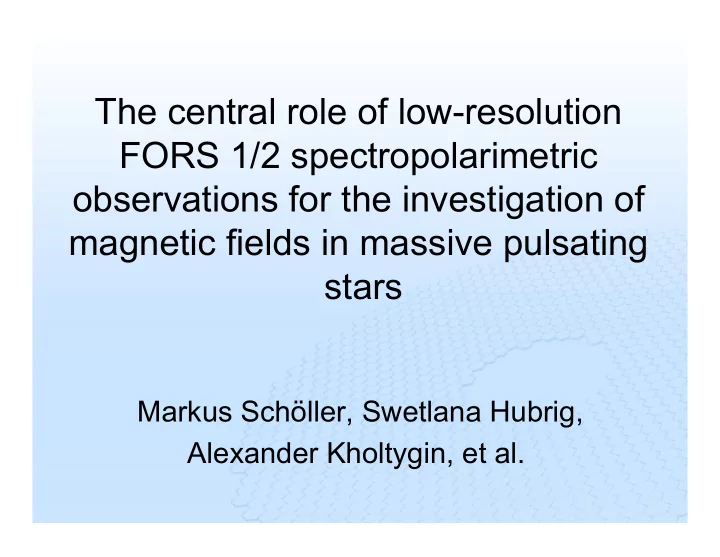

The central role of low-resolution FORS 1/2 spectropolarimetric observations for the investigation of magnetic fields in massive pulsating stars Markus Schöller, Swetlana Hubrig, Alexander Kholtygin, et al.
Polarization V spectra observed with FORS1/2 α gives the position angle of the retarder waveplate and f o and f e are ordinary and extraordinary beams, respectively.
Determination of the magnetic field The mean longitudinal magnetic field is the average over the stellar hemisphere visible at the time of observation of the component of the magnetic field parallel to the line of sight. It is diagnosed from the slope of the linear regression:
Surveys of magnetic fields in pulsating B-type stars with FORS1 Prior to our survey: 2 magnetic β Cephei stars and 1 magnetic SPB star Magnetic field survey of pulsating B-type stars with FORS1: 34 stars (2003-2005) + 53 stars (2009) The β Cephei star ξ 1 CMa, with a longitudinal magnetic field of the order of 300 − 350G, was then the largest among the known magnetic β Cep stars (see poster A1 on HD 96446) Hubrig et al. (2006)
Surveys of magnetic fields in pulsating B-type stars with FORS1 For the target selection we used the following criteria: a) nitrogen-rich b) radial pulsations or multiperiodic pulsations dominated by a radial mode ( β Cephei stars), although a few stars pulsate non-linearly c) Geneva photometric observations available d) slow rotation e) identified pulsation modes f) no SB2 systems
The rotation period of ξ 1 CMa (FORS1/2) P = 2.1795 d (Hubrig et al. 2006, 2011): B d ~ 5.3kG FORS1/2 (exposure times of 0.25s; V = 4.3) Peak-to-peak RV amplitudes reach 33 km/s
The rotation period of ξ 1 CMa (FORS1/2) Fourtune-Ravard et al. 2011: P ~ 4.2680 d (ESPaDOnS, long exposures corresponding to a significant fraction of the pulsation period ) ESPaDOns + two old obs. with MuSiCoS è P rot ~ 60yrs (Shultz et al. 2015) P = 2.1795 d (Hubrig et al. 2006, 2011) The target is not in a favourable position to be observed from Pic du Midi (elevation ~20 ¢ ).
Discovery of X-ray pulsations in ξ 1 CMa (Oskinova et al. 2014) Sequence of X-ray images clearly shows intensity of emission changing with time Evident in the light curve: count rate measured by the EPIC PN camera vs. time after the start of observation
Earlier X-ray pulsation detections? X-ray light curves (0.2-10.0 keV) of β Cephei variables. The red colour shows the hard band (1.0-10.0 keV). The detection for β Cru was reported by Cohen et al. (2008).
Earlier X-ray pulsation detections? Power density spectra based on the Fourier transform. Various false alarm probability levels are marked. For two stars the detected periods are spurious at a probability of 50% and more (Oskinova et al. 2015).
The A0 supergiant HD 92207 • Hubrig et al. (2012) announced a longitudinal magnetic field of <B z > = − 384 ± 42 G in this star • Bagnulo et al. (2013) claimed that this was a spurious detection, blaming mainly instrument flexures • Hubrig et al. (2014) looked again at the data and concluded that there are spectral variations intrinsic to HD 92207 • Hubrig et al. (2015) reobserved HD 92207 and could confirm the presence of a weak magnetic field
Issue: “flexures” No variability detected for other targets observed in the same night in similar conditions: same airmass, similar exposure times
The A0 supergiant HD 92207 Short-term spectral variability on a time scale of minutes in HD 92207 (Hubrig et al. 2014). Given the size of the supergiant, the variability cannot be referred to coherent line variations across the entire surface.
Issues: “coherence time” Fossati et al. (2015): seeing variations during the exposure Yet: coherence time is in milliseconds, NOT in seconds.
Evidence for variations in an O-type giant (Kholtygin et al., in prep.) Dynamical spectra Cleaned Fourier spectra H δ H γ He II H β 4686 P ~ 4-5 min P ~ 24-34 min
Magnetic fields in δ Scuti stars • Kurtz et al. (2008) were the first to discover a magnetic field in a δ Scuti star (HD 21190): <B z > = 47±13 G • Neiner & Lampens (2015) claimed that they were the first to detect a magnetic field in a δ Scuti star (HD 188774) • However, Hubrig & Schöller (2016) reobserved HD 21190 and found <B z > = − 254±59 G
Issue: Spectrum extraction Grey: Fluxes extracted by Bagnulo et al. (2015) Black: Fluxes extracted by our pipeline from left to right: the HgMn star α And, the δ Scuti star HD 21190, the nitrogen rich early B-type star HD 52089, and the Herbig Ae star PDS 2. All these stars were announced in our studies as magnetic. The most probable reason for the lower flux is a smaller extraction window to overcome reflections in the FORS spectra around H δ .
Summary • Short exposure times are necessary to adequately sample pulsation periods when looking for magnetic fields • This can best be achieved with low resolution spectropolarimetry on large telescopes • (Super)giants are good candidates to find another class of unexpected pulsators – go and observe them
Recommend
More recommend